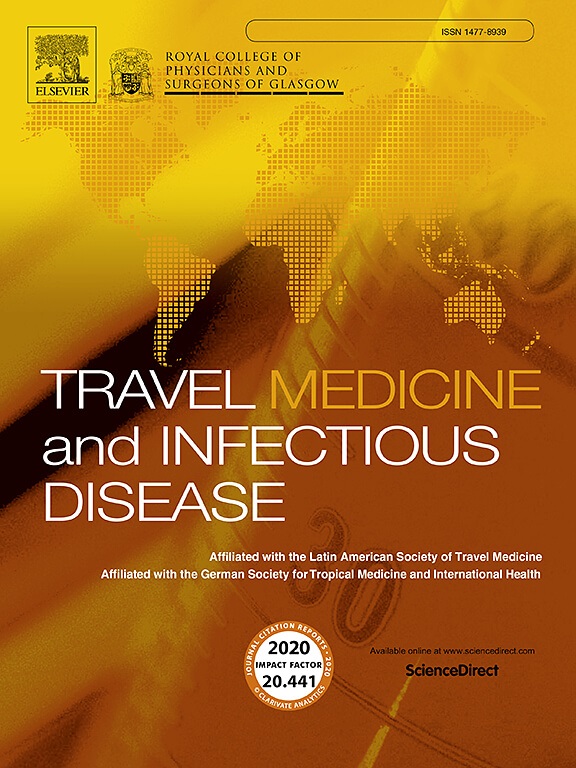Fever in travelers returning from tropical and subtropical areas: a hospital-based study of factors affecting investigations and diagnoses in children and adults
IF 4.7
3区 医学
Q1 INFECTIOUS DISEASES
引用次数: 0
Abstract
Background
As global travel surges in the post-pandemic era, healthcare systems must prepare for proper management of diseases encountered by returning travelers.
Method
A retrospective study of the management of returning travelers from tropical or subtropical regions, with fever at the adult and paediatric emergency departments of Karolinska University Hospital, Stockholm Sweden. Demographics, travel history, clinical and microbiology data were extracted from health records. Multivariate regression analyses identified factors affecting investigations and diagnoses.
Results
A total of 2441 patients (2197 adults, 244 children) were included. An etiological diagnosis was confirmed in 63.3 % (n = 1546) of patients; with malaria (5.6 %, n = 138), dengue (4.0 %, n = 98) and typhoid fever (0.9 %, n = 22) being the most common tropical infections. Patients with fever >38 °C (aOR 1.48, 95 % CI 1.20–1.84) or hospitalization (aOR 4.68, 95 % CI 3.23–6.80) had higher odds of etiological diagnosis. Children were less likely than adults to have a cause of fever diagnosed (OR 0.64, 95 % CI 0.49–0.84). Malaria testing was lower in children than adults who had visited Sub-Sahara Africa (80.6 % vs 90.4 %). Overall, a lower proportion of children underwent blood cultures, compared to adults (29.5 % vs 68.7 %). VFR travelers and migrants had lower probability of other microbiological investigations when malaria testing was negative (aOR 0.69, 95 % CI 0.54–0.90; aOR 0.67, 95 % CI 0.50–0.90).
Conclusion
The management of febrile patients following tropical travel varied significantly across different patient groups. Children, migrants and VFR travelers often receive less thoroughly investigations. This highlights the need for equitable management and investigation, especially for these vulnerable populations.
从热带和亚热带地区返回的旅行者发烧:一项影响儿童和成人调查和诊断因素的基于医院的研究
随着大流行后时代全球旅行的激增,卫生保健系统必须做好准备,妥善管理回国旅行者遇到的疾病。方法回顾性分析瑞典斯德哥尔摩卡罗林斯卡大学医院成人和儿科急诊科对从热带或亚热带地区返回的发热旅客的处理情况。从健康记录中提取人口统计学、旅行史、临床和微生物学数据。多变量回归分析确定了影响调查和诊断的因素。结果共纳入2441例患者,其中成人2197例,儿童244例。63.3% (n = 1546)的患者确诊为病因学诊断;疟疾(5.6%,n = 138)、登革热(4.0%,n = 98)和伤寒(0.9%,n = 22)是最常见的热带感染。发热38°C (aOR 1.48, 95% CI 1.20 ~ 1.84)或住院(aOR 4.68, 95% CI 3.23 ~ 6.80)患者的病因诊断几率较高。儿童确诊发热原因的可能性低于成人(OR 0.64, 95% CI 0.49-0.84)。访问过撒哈拉以南非洲的儿童的疟疾检测低于成人(80.6%对90.4%)。总体而言,与成人相比,儿童接受血液培养的比例较低(29.5%对68.7%)。当疟疾检测呈阴性时,VFR旅行者和移民进行其他微生物调查的可能性较低(aOR 0.69, 95% CI 0.54-0.90;(or 0.67, 95% CI 0.50-0.90)。结论不同人群对热带旅行后发热患者的处理存在显著差异。儿童、移民和VFR旅行者往往受到的调查不那么彻底。这突出了公平管理和调查的必要性,特别是对这些弱势群体。
本文章由计算机程序翻译,如有差异,请以英文原文为准。
求助全文
约1分钟内获得全文
求助全文
来源期刊

Travel Medicine and Infectious Disease
PUBLIC, ENVIRONMENTAL & OCCUPATIONAL HEALTH-INFECTIOUS DISEASES
CiteScore
19.40
自引率
1.70%
发文量
211
审稿时长
49 days
期刊介绍:
Travel Medicine and Infectious Disease
Publication Scope:
Publishes original papers, reviews, and consensus papers
Primary theme: infectious disease in the context of travel medicine
Focus Areas:
Epidemiology and surveillance of travel-related illness
Prevention and treatment of travel-associated infections
Malaria prevention and treatment
Travellers' diarrhoea
Infections associated with mass gatherings
Migration-related infections
Vaccines and vaccine-preventable disease
Global policy/regulations for disease prevention and control
Practical clinical issues for travel and tropical medicine practitioners
Coverage:
Addresses areas of controversy and debate in travel medicine
Aims to inform guidelines and policy pertinent to travel medicine and the prevention of infectious disease
Publication Features:
Offers a fast peer-review process
Provides early online publication of accepted manuscripts
Aims to publish cutting-edge papers
 求助内容:
求助内容: 应助结果提醒方式:
应助结果提醒方式:


